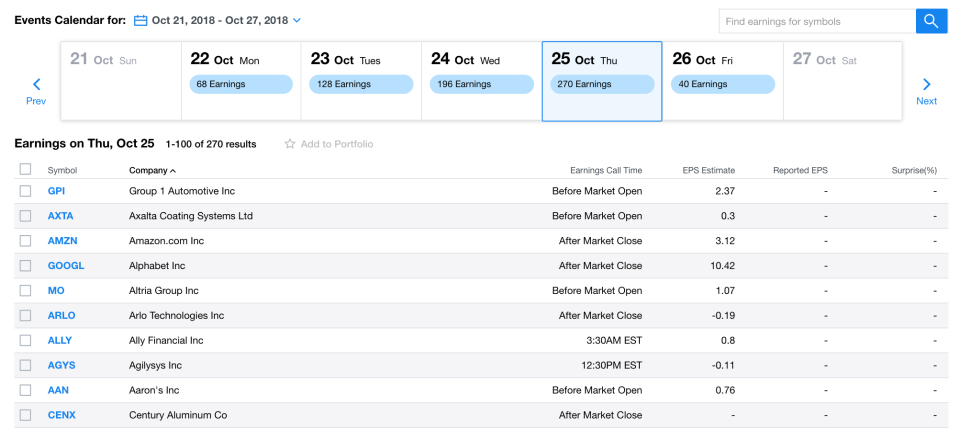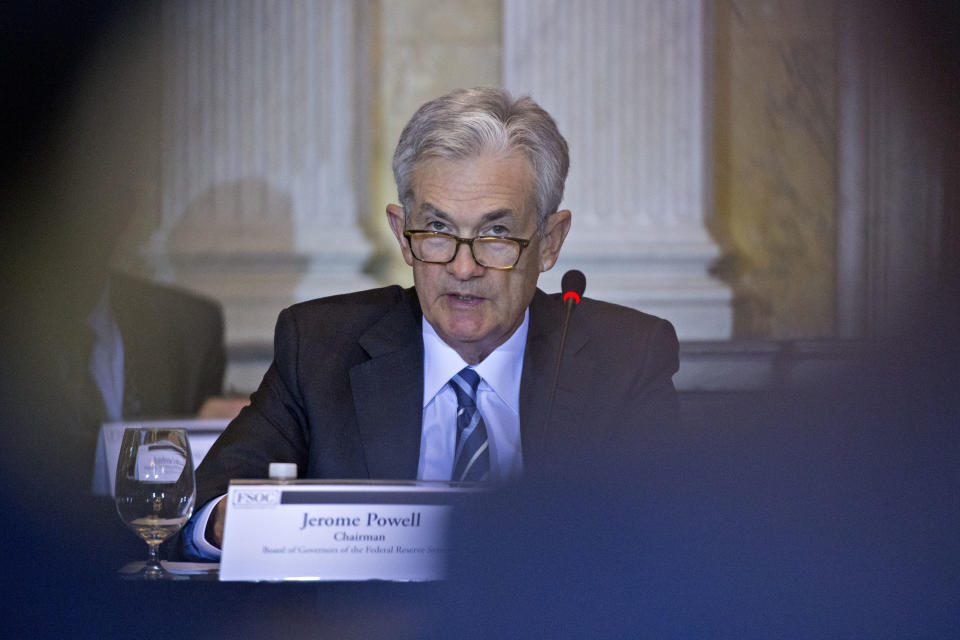There are '4 headwinds' facing markets right now
Recent choppiness in equity trading has sent investors scrambling to explain the selloff.
For trader and Sevens Report founder Tom Essaye, markets are working against four trends: lukewarm earnings, macroeconomic events, trade tensions with China, and an increasingly hawkish Fed.
“Those are the four headwinds facing markets,” Essaye told Yahoo Finance’s Morning Movers on Monday. “And appropriately so, markets are sort of digesting them and fighting through them. And that’s why we had volatility.”
The S&P 500 (^GSPC) and Dow (^DOW) are each down about 5% in October, while the Nasdaq (^IXIC) is down about 7% for the month to date, as of market close Monday. The S&P 500 and the Dow both posted their largest single-day declines since February on October 10 before paring some losses in the days following.

Here’s a look at each of the four “headwinds”:
Earnings
Third-quarter earnings season kicked off to a tepid start, Essaye said.
“The first week of earnings was not great,” Essaye said, as markets head into the third week of results. “It wasn’t terrible, but it wasn’t great.”
Essaye noted that investors should look toward guidance more so than raw numbers when it comes to results, since “the earnings game is a bit of a rigged game because so many companies beat” low-balled estimates.
“Really what we want to see is positive commentary from management — that No. 1, margins aren’t being squeezed, and No. 2, international business isn’t falling off of a cliff,” Essaye said. “Any commentary that pushes back on those concerns will be a positive for the market.”

In October so far, the one-month ratio of above-consensus versus below-consensus earnings guidance has come in at 1.0, above the historical October average of 0.8, Bank of America analyst Savita Subramanian said. The three-month ratio registers at 0.6, beneath the long-term average of 0.7.
But with only about 30 instances of guidance in October so far, “the coming week will be key, when companies across a broader range of sectors will report,” Subramanian said.
About one-third of S&P 500 companies are set to report earnings this week, consisting of companies across all 11 major sectors.
Macroeconomic Events
Overseas events in Europe have spooked investors on both sides of the Atlantic, with Italy’s budget situation presenting a particular “macroeconomic overhang,” Essaye said.
The European Union could decide this week whether to require that Italy revise its draft budget, which presently includes measures to cut taxes, reform pensions, and introduce a universal income. These points, introduced by the populist government, would raise Italy’s budget deficit to 2.4% in 2019, wider than the 0.8% deficit expected under the previous government. Italy already boasts debt equal to 131.2% of its gross domestic product, according to Eurostat data.
Italy’s FTSE MIB index is down about 8% in October amid uncertainty over the country’s budget. Moody’s Investors Service downgraded Italy’s sovereign debt rating by a notch to Baa3 last Friday, or one level above “junk.”
US–China Trade Tensions
Strained relations between two of the world’s largest economies have weighed on both American and Chinese markets as concerns over supply chains and tariffs continue to brew.
About 30 companies have mentioned tariffs or the trade war during earnings calls so far, Bank of America’s Savita Subramanian pointed out.

While a majority indicated limited or no impact on their businesses so far, “a number have cited negative impact,” Subramanian said. As examples, PPG Industries (PPG) highlighted modest increases in raw material costs, and Honeywell International (HON) expects the impact to be in the hundreds of millions of dollars in 2019 versus the tens of millions of dollars in 2018.
The tariffs on $200 billion worth of Chinese goods unleashed in September at a rate of 10% will increase to 25% at the end of the year. China has continued to hit back with retaliatory tariffs, recently on $60 billion worth of U.S.-made products.
“Overall, the impact from tariffs seems too early to tell, but any significant deterioration in outlooks around tariffs/trade or growth would pose risk to (capital expenditure),” Subramanian said.
Monetary Policy
Finally, Essaye pointed to the “Fed turning slightly hawkish” as a headwind to equities. Minutes released from the Federal Open Market Committee’s latest meeting suggest that officials are comfortable continuing a trend of gradually increasing interest rates, which sent bond yields rising and equities competing for capital sinking.
The yield on the 10-year Treasury note rose at the end of last week as investors digested meeting minute comments suggesting that the central bank could raise interest rates above a neutral level. The Federal Reserve last raised rates 25 basis points in September to between 2% and 2.25%.

FOMC officials cited a promising economic outlook as a reason for their comfort in raising rates, with several expecting “it would be necessary to temporarily raise the federal funds rate above their assessments of its longer-run level in order to reduce the risk of a sustained overshooting of the Committee’s 2% inflation objective or the risk posed by significant financial imbalances.”
The Federal Reserve is largely expected to raise rates for a fourth time this year in December.
What’s Next?
Essaye added that he would be concerned if volatility continues to rise.
“What we’ve seen typically in these types of pullbacks is the VIX spikes, and the market drops, the drop is overdone, but then we sort of churn,” Essaye said. “And the VIX does not make a new high, which tells us that the market is in the process of putting in a bottom. If the VIX makes a new high this week, that will be concerning to me, because that will make this selloff different from the previous ones this year.”
Analysts at Morgan Stanley wrote in a note that last week’s rebound in equity markets “was a dead cat bounce with the downtrend resuming on Thursday. We look for confirmation with a definitive break of the S&P 500 through its 200-day moving average.”
“We don’t think the correction is done yet,” the analysts added. “We think attempts to rebound were more short-lived than sustainable.”
—
Emily McCormick is a reporter for Yahoo Finance. Follow her on Twitter: @emily_mcck
Read more from Emily:
Weed stock Tilray is sending investors on an incredible ride
Tilray shares jump as company says it’s exporting cannabis to sick children in Australia
A trade war won’t rattle the ‘white hot’ US economy
White House economist: Tariffs are hurting China much more than the US